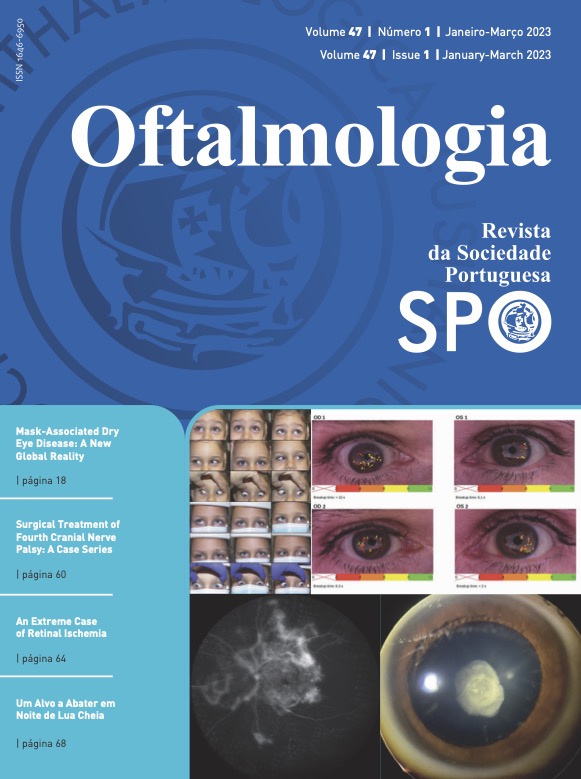Adequacy of Referrals for First Consultation in Ophthalmology
DOI:
https://doi.org/10.48560/rspo.28272Keywords:
Ophthalmology, Primary Health Care, Referral and Consultation, SpecializationAbstract
INTRODUCTION: In the Portuguese National Health System, the General Practitioner (GP) is usually the first medical contact of the patient, at the primary health care level, and the gatekeeper for referral to other medical and surgical specialties (through a P1 request). This refer- ral process is complex and susceptible to great variability, due to the frequent absence of guide- lines. Thus, the aim of this study was to evaluate the referral process made by GP physicians to Ophthalmology, namely the level of concordance between the chosen priority and the clinical scenario, and between the clinical scenario described in the referral letter and that which was de- scribed by the ophthalmologist upon seeing the patient.
METHODS: In this cross-sectional observational study, the electronic health records of 1500 randomly selected first appointments of the Ophthalmology Department of Centro Hospitalar Universitário do São João, and their respective P1 requests were analyzed, out of a total of 9340 first appointments performed in 2019. Information was collected on the priority of the request, reason for the request, symptoms, signs, diagnoses, and clinical orientation provided by the oph-thalmologist.
RESULTS: No predictor of the P1 priority was identified, namely regarding the patient’s signs and symptoms or diagnosis suspected by the GP in the P1 request. A general lack of con- cordance was also observed between the signs and symptoms referred in the P1 request and those identified in the consultation.
CONCLUSION: This study reinforces the need for the creation of objective protocols that help GP practitioners in decision making when referring patients to Ophthalmology, regarding the priority of the requests, as well as the destination of the referral (Outpatient consultation or Emergency Department), in order to make the whole process more cost-effective, maximize avail- able healthcare resources and ensure patient satisfaction and timely management.
Downloads
References
Grimshaw JM, Winkens RA, Shirran L, Cunningham C, Mayhew A, Thomas R, et al. Interventions to improve outpatient referrals from primary care to secondary care. Cochrane Database Syst Rev. 2005:CD005471. doi: 10.1002/14651858. CD005471.
Saude Md. Estratégia Nacional para a Saúde da Visão. Lisboa: Saude SNd; 2018.
Diário da República n.o 71/2014, Série I de 2014-04-10., 2364 - 6. 4. Saúde SNd. Centro Hospitalar Universitário de São João (CHUSJ). [accessed Jan 2021] Available from: https://portal- chsj.min-saude.pt/pages/2?fbclid=IwAR3JJjLA_FomHwkpti-o9Fhi9cZKdCFwSNfQoHCYVbFGlt5uJLW-NYsDHdfw.
Forrest CB, Nutting PA, von Schrader S, Rohde C, Starfield B. Primary care physician specialty referral decision making: patient, physician, and health care system determinants. Med Decis Making. 2006;26:76-85. doi: 10.1177/0272989X05284110.
Thorsen O, Hartveit M, Baerheim A. General practitioners’ reflections on referring: an asymmetric or non-dialogical process? Scand J Prim Health Care. 2012;30:241-6. doi: 10.3109/02813432.2012.711190.
Salem-Schatz S, Moore G, Rucker M, Pearson SD. The case for case-mix adjustment in practice profiling. When good apples look bad. JAMA. 1994;272:871-4.
Franks P, Zwanziger J, Mooney C, Sorbero M. Variations in primary care physician referral rates. Health Serv Res. 1999;34:323-9.
Rocha Neves J, Casal Moura M, Ferreira A, Sousa J, Gamas L, Vieira M, et al. Referenciação e articulação de cuidados entre cuidados de saúde primários e cuidados hospitalares de an- giologia e cirurgia vascular – experiência de um centro. Rev Port Cir Cardiotorac Vasc. 2018;25:41-8.
Torres T, Henrique M, Oliveira H, Rodrigues M, Ferreira P, Morais P, et al. Abordagem do Doente com Psoríase pela Me- dicina Geral e Familiar: Algoritmo de Referenciação e Gestão Partilhada com a Dermatologia. Acta Med Port. 2021;34:682-9. doi: 10.20344/amp.13159.
Downloads
Published
How to Cite
Issue
Section
License
Copyright (c) 2023 Revista Sociedade Portuguesa de Oftalmologia

This work is licensed under a Creative Commons Attribution-NonCommercial 4.0 International License.
Do not forget to download the Authorship responsibility statement/Authorization for Publication and Conflict of Interest.
The article can only be submitted with these two documents.
To obtain the Authorship responsibility statement/Authorization for Publication file, click here.
To obtain the Conflict of Interest file (ICMJE template), click here





